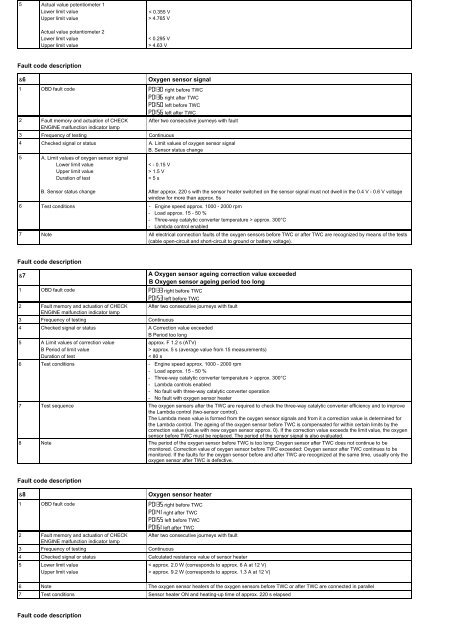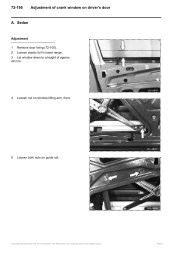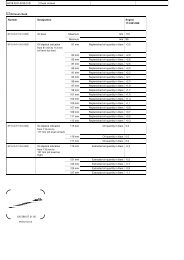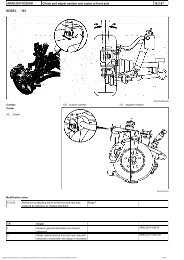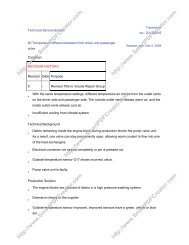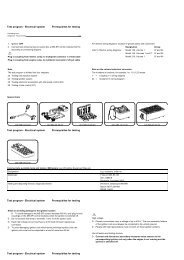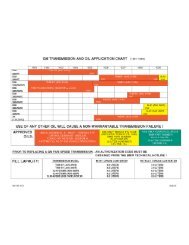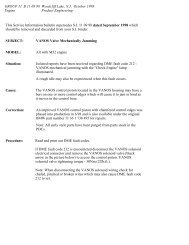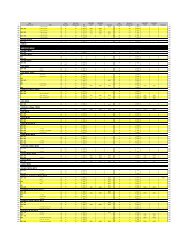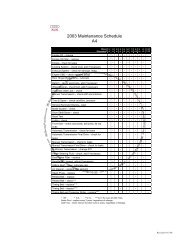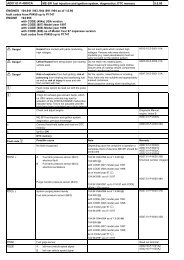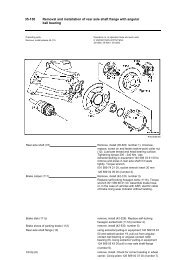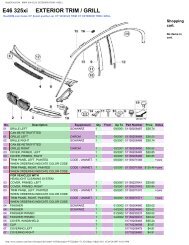W140 Fault Codes_ Description.pdf
W140 Fault Codes_ Description.pdf
W140 Fault Codes_ Description.pdf
Create successful ePaper yourself
Turn your PDF publications into a flip-book with our unique Google optimized e-Paper software.
5 Actual value potentiometer 1Lower limit valueUpper limit value< 0.355 V> 4.765 VActual value potentiometer 2Lower limit valueUpper limit value< 0.295 V> 4.63 V<strong>Fault</strong> code description&6 Oxygen sensor signal1 OBD fault code P0I30 right before TWCP0I36 right after TWCP0I50 left before TWCP0I56 left after TWC2 <strong>Fault</strong> memory and actuation of CHECK After two consecutive journeys with faultENGINE malfunction indicator lamp3 Frequency of testing Continuous4 Checked signal or status A. Limit values of oxygen sensor signalB. Sensor status change5 A. Limit values of oxygen sensor signalLower limit valueUpper limit valueDuration of test< - 0.15 V> 1.5 V< 5 sB. Sensor status changeAfter approx. 220 s with the sensor heater switched on the sensor signal must not dwell in the 0.4 V - 0.6 V voltagewindow for more than approx. 5s6 Test conditions - Engine speed approx. 1000 - 2000 rpm- Load approx. 15 - 50 %- Three-way catalytic converter temperature > approx. 300°C- Lambda control enabled7 Note All electrical connection faults of the oxygen sensors before TWC or after TWC are recognized by means of the tests(cable open-circuit and short-circuit to ground or battery voltage).<strong>Fault</strong> code description&7 A Oxygen sensor ageing correction value exceededB Oxygen sensor ageing period too long1 OBD fault code P0I33 right before TWCP0I53 left before TWC2 <strong>Fault</strong> memory and actuation of CHECK After two consecutive journeys with faultENGINE malfunction indicator lamp3 Frequency of testing Continuous4 Checked signal or status A Correction value exceededB Period too long5 A Limit values of correction valueB Period of limit valueDuration of testapprox. F 1.2 s (ATV)> approx. 5 s (average value from 15 measurements)< 80 s6 Test conditions - Engine speed approx. 1000 - 2000 rpm- Load approx. 15 - 50 %- Three-way catalytic converter temperature > approx. 300°C- Lambda controls enabled- No fault with three-way catalytic converter operation- No fault with oxygen sensor heater7 Test sequence The oxygen sensors after the TWC are required to check the three-way catalytic converter efficiency and to improvethe Lambda control (two-sensor control).The Lambda mean value is formed from the oxygen sensor signals and from it a correction value is determined forthe Lambda control. The ageing of the oxygen sensor before TWC is compensated for within certain limits by thecorrection value (value with new oxygen sensor approx. 0). If the correction value exceeds the limit value, the oxygensensor before TWC must be replaced. The period of the sensor signal is also evaluated.8 Note The period of the oxygen sensor before TWC is too long: Oxygen sensor after TWC does not continue to bemonitored. Correction value of oxygen sensor before TWC exceeded: Oxygen sensor after TWC continues to bemonitored. If the faults for the oxygen sensor before and after TWC are recognized at the same time, usually only theoxygen sensor after TWC is defective.<strong>Fault</strong> code description&8 Oxygen sensor heater1 OBD fault code P0I35 right before TWCP0I4I right after TWCP0I55 left before TWCP0I6I left after TWC2 <strong>Fault</strong> memory and actuation of CHECK After two consecutive journeys with faultENGINE malfunction indicator lamp3 Frequency of testing Continuous4 Checked signal or status Calculated resistance value of sensor heater5 Lower limit valueUpper limit value< approx. 2.0 W (corresponds to approx. 6 A at 12 V)> approx. 9.2 W (corresponds to approx. 1.3 A at 12 V)6 Note The oxygen sensor heaters of the oxygen sensors before TWC or after TWC are connected in parallel7 Test conditions Sensor heater ON and heating-up time of approx. 220 s elapsed<strong>Fault</strong> code description


